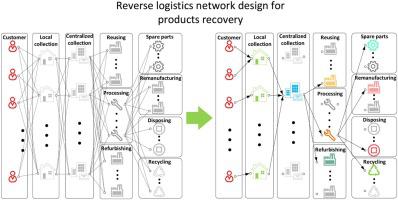Journal of Manufacturing Systems ( IF 12.2 ) Pub Date : 2021-07-13 , DOI: 10.1016/j.jmsy.2021.06.012 Erfan Shafiee Roudbari 1 , S.M.T. Fatemi Ghomi 1 , Mohsen S. Sajadieh 1

|
With the improvement of the quality of life in human society, the need to use more natural resources is felt more than ever. In this regard, much research has been done on restoring depreciated and consumed products to the supply chain; many factors, including the quality of returned products, can significantly impact how the reverse logistics network will be used. The two-stage stochastic mixed-integer programming model proposed in this paper considers various processes of recovering recyclable products, including reuse, refurbishing, remanufacturing, recycling, and selling spare parts. Also, considering uncertainty on quality and quantity of returned products, product variety, and bill of material are model features. Due to the computational complexity of large-scale problems, such problems require considerable time to solve. To tackle this issue, a hybrid algorithm constructed by a genetic algorithm and branch and cut algorithm (with CPLEX solver) has been introduced, which can significantly reduce the solution time. Finally, the algorithm is applied to a real-world problem to design a reverse logistics network for a small-size laboratory equipment manufacturer.
中文翻译:

不确定性下产品再利用、再制造、回收和翻新的逆向物流网络设计
随着人类社会生活质量的提高,人们比以往任何时候都更加需要使用更多的自然资源。在这方面,已经做了很多关于将折旧和消耗的产品恢复到供应链的研究;许多因素,包括退回产品的质量,都会显着影响逆向物流网络的使用方式。本文提出的两阶段随机混合整数规划模型考虑了回收可回收产品的各个过程,包括再利用、翻新、再制造、回收和销售备件。此外,考虑退货质量和数量的不确定性、产品种类和物料清单是模型特征。由于大规模问题的计算复杂性,此类问题需要相当长的时间来解决。为了解决这个问题,引入了一种由遗传算法和分支和切割算法(使用 CPLEX 求解器)构建的混合算法,可以显着减少求解时间。最后,将该算法应用于实际问题,为一家小型实验室设备制造商设计逆向物流网络。











































 京公网安备 11010802027423号
京公网安备 11010802027423号